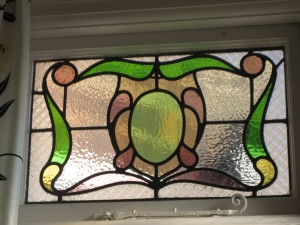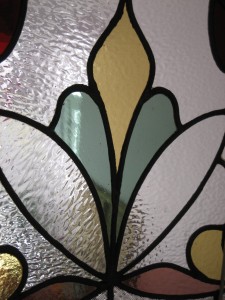Coloured and decorative glass is a distinguishing feature of Edwardian houses of all sizes. The wide plots of suburban development in the 1900s allowed for larger windows than previously seen in small and medium sized houses. The trend – first in architect-designed houses and then in those built speculatively – was for the lower part of the window to be of clear glass, with the upper part made up of smaller panes which would often include coloured glass or leading.
There were several reasons for the popularity of decorative glass. It was attractive, of course, and provided a simple way for builders to make their new houses appear fashionable and up to date. It enhanced the appearance of the interior, and with the spread of electric lighting, decorative glass also added to the external visual appeal of the house. A walk at dusk along the streets of Edwardian Palmers Green still offers many glimpses of jewel-like colour from front doors and windows, and the effect would have been more striking when the houses were first built.
 Another benefit was the additional privacy that decorative glass offered. This was perhaps particularly important in newly developed suburban streets where long rows of houses faced each other, and curtains twitched from time to time. Stained glass was used as standard in the large flanking windows used to light halls and stairwells, sometimes known as ‘cathedral windows’. It was also used where the ‘service’ parts of the house met the living accommodation, such as the entrance to the kitchen. In locations where privacy was less of a concern, such as french windows connecting the drawing-room to the back garden, coloured glass was valued simply for its aesthetic qualities, and could be used with a lighter touch.
Another benefit was the additional privacy that decorative glass offered. This was perhaps particularly important in newly developed suburban streets where long rows of houses faced each other, and curtains twitched from time to time. Stained glass was used as standard in the large flanking windows used to light halls and stairwells, sometimes known as ‘cathedral windows’. It was also used where the ‘service’ parts of the house met the living accommodation, such as the entrance to the kitchen. In locations where privacy was less of a concern, such as french windows connecting the drawing-room to the back garden, coloured glass was valued simply for its aesthetic qualities, and could be used with a lighter touch.
As with many of the distinctive ‘craft’ features of Edwardian speculative housing, decorative glass could be obtained relatively cheaply from building suppliers, in a wide variety of styles and designs. This spread of mass-produced decoration produced a reaction among leaders of taste; the architect M H Baillie Scott warned in 1895 that
“the average stock patterns of the manufacturer are more suggestive of the gin palace than the private house, and should be carefully avoided”[1]

In response, simpler designs became fashionable by the Edwardian period, partly influenced by the Arts and Crafts and Art Nouveau movements. A stock version of Art Nouveau is probably the most widely seen type of decorative glass in Edwardian Palmers Green, with a variety of greens, mauves, yellows and reds set into clear leaded panels which suggest stylised, symmetrical flowers and semi-heraldic motifs.
One reply on “Stained and leaded glass”
We have recently moved into New River Crescent and can see lots of examples of these doors and surrounds – unfortunately ours is not one of them, with the original having been replaced long ago. I’d love to replace the door with something more in-keeping with the others, so if anyone has any ideas as to where I could find/buy one, I’d be very grateful.